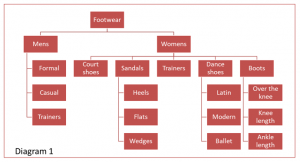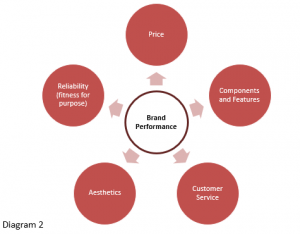What are Brand Categories?
To understand brand categories, we need to think of brands as potential hierarchies, with superior and inferior categorization of products.
Think of a company that produces footwear – how would a breakdown of their products work?
Diagram 1 shows the hierarchical decomposition of the various types of shoes and boots.
The breakdown is clear, men’s/women’s and the different types and sub-types. Once established, any new product fits neatly into a well-ordered framework that everyone can understand.
Applying a branding approach to this product category breakdown allows the development of a master brand (at the ‘footwear’ level), with sub-brands for men’s and women’s and potential further branding for formal, casuals, sports, dance and boots.
Reviewing the category diagram gives insight into the strategic positioning of the categories. Gaps in the range will become apparent and, linked to marketing surveys and other feedback, will provide an insight into the associations that consumers form.
These associations may be positive or negative in nature and can shape the perception of the brand, thus impacting on whether consumers choose or avoid the brand, when making purchasing decisions.
An example of this is the motor car manufacturing company, Skoda. For many years, the Czech based company manufactured vehicles that were the subject of many jokes amongst consumers – “how do you double the value of a Skoda? – fill the gas tank”. The brand value had been devalued and the brand perception tarnished, by products that performed poorly, looked ugly and lost value very quickly.
When Volkswagen-Audi Group acquired the Skoda motor car business, they invested heavily in the factories and creating more modern designs, using the group’s experience in producing attractive, well made and respected vehicles and over the course of many years, the consumer perception changed. These days, Skoda is a well respected and liked brand, leading to strong sales and positive brand associations.
The shrewd brander will develop such a category-based approach carefully and it is very important that the brand is authentic and true to its values – so are the trainers in the footwear range example sports shoes or fashion shoes? A dedicated sports person will be looking for the former, a different consumer for the latter.
The difference in the shoe purpose will have an impact on the cost and thus pricing, so a competitive sports shoe will inevitably cost more to produce than one intended for causal wear and light sports use. Branding each accordingly will help the consumer choose the best fit product and in turn help the brand’s image.
Brand Image
The brand image arises from a combination of different associations. The consumer will judge brand performance from a series of associations that are important to them – diagram 2 shows a typical set of associations.
Choosing brand categories carefully and building them in response to consumer perception will increase band value and maximise the return from the products.
It’s all about how the consumer regards the brand. The strongest brands create passion and engagement, which creates equity. So, it can be said that the consumers are the ultimate creators of brand value and brand image is crucial to this process.
,
Conclusion
Brand categories provide flexibility in responding to different consumer segments, each of which demand specific brand images.
The GLOMACS’ portfolio of training courses covers, Strategic Brand Management, Strategic Brand Development and Performance Management, Strategic Brand Positioning and Marketing, Marketing and Branding in a Post-Pandemic World that will provide participants with the fundamental understanding of how to manage brands strategically, as well as providing a useful set of tools and techniques to help you achieve their goals.







